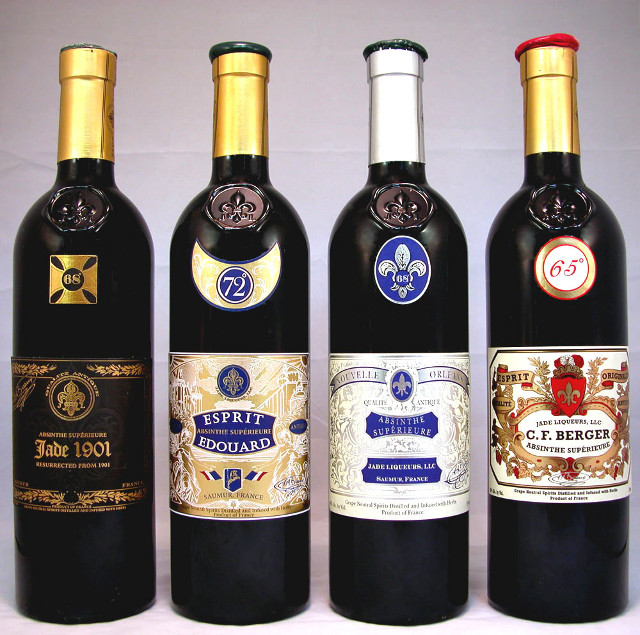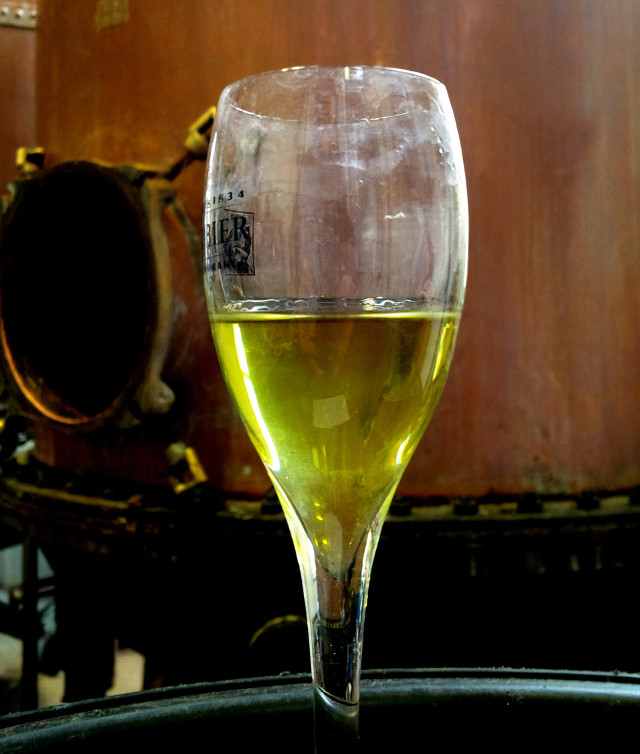The resurgence of authentic absinthe culture in the early 2000s involved a long process. Inauthentic products dominated the European market, and old bans were still active in some countries. Legal restrictions and wide-spread miscalculations regarding the chemical composition of original absinthes made it unthinkable for producers to utilize original historic recipes. American chemist T.A. Breaux, founder and president of Jade Liqueurs, helped bring about a fundamental change to this situation:
I started Jade Liqueurs in 2000. In that year, I became the first person to analyze samples drawn from full, sealed preban bottles using modern scientific methods. When these analyses revealed nothing harmful in these old bottles, I founded Jade Liqueurs with the mission of distilling absinthe true to historical tradition, which no one was doing at that time.
Jade absinthes are produced in collaboration with the western French distillery Combier, which was founded in 1834. Absinthe was already produced there in preban times, and some of the elements of the production facilities still stem from that era.
The Absinthes
All Jade absinthes are based on a diverse selection of historic absinthes. Some of those originals are the absinthes Breaux acquired for scientific analysis, while others are recreated based on historical records. The diversity of these model absinthes carries over into Jade's products.
The product range currently includes five different absinthes:
C.F. Berger (Verte Suisse 1898)
Jade also offers its own "eau de vie", a wine alcohol that serves as the base for the absinthes:
Jade absinthes enjoy an excellent reputation, reflected in international competitions and frequent media coverage:
Jade’s products are the recipients of numerous international awards, including the International Wine and Spirits competition (London). The quality and authenticity of Jade’s products have
been acknowledged by various publications and media throughout the world, including Difford’s Guide, Wine Enthusiast, and television programs on networks such as The History Channel, The Discovery Channel, The Travel Channel, etc.
The production
T.A. Breaux details the production steps. The production involves not only historical methods, but, remarkably, also machinery that itself is a part of absinthe history.
All Jade absinthes are distilled using the original 19th century 'bain marie' alambics at the historical Combier distillery in Saumur, France.
The Combier distillery purchased these 1,150L alembics a century ago from what was perhaps the most famous absinthe distillery in the French Pontarlier, birthplace of "Absinthe Pernod Fils", the first absinthe to be produced in France.
Gustave Eiffel redesigned Combier's still room in 1894, which is still apparent in its elaborate architecture.
All Jade absinthes are distilled using the traditional Methode Suisse, from 19th century style eau de vie.
"Absinthe Suisse" (Swiss Absinthe) in this context does not refer to the place of origin. Rather, "Absinthe Suisse" was used to signify one of the common levels of quality, which were used to categorize absinthe during preban times. "Absinthe Suisse" was regarded as the highest level of quality.
These absinthes are traditionally produced via the maceration of herbs in alcohol, which is subsequently distilled. The coloring of green, or verte, "Absinthe Suisse" requires a shorter second maceration.
Jade absinthes utilize privately grown botanicals, including two different cultivars (Pontarlier and Swiss) artemisia absinthium. In keeping true to tradition, all Jade absinthes are rested for an average of 3 years before bottling.
Jade absinthes are never made from assemblages or cold mixing, and do not contain commercial flavorings, sugar, or dye. From the fields to the bottle, everything about Jade absinthes is as it was in the 19th century.
The recipes stem from a combination of historic manuals and scientific analyses of preban absinthes.
Our production methods are painstakingly authentic, without compromises, and follow the exact crafting steps of the most famous original distillers. Our protocols are derived from scientific analyses of original pre-ban absinthes and written historical records. Uncompromised historical authenticity has always been the top priority at Jade Liqueurs.
A Difficult Resurrection
Strict commitment to historic methods of production was unique when Jade Liqueurs was founded. Nearly all companies made their products through the cold mixing of starch distillates (vodka), artificial flavorings, and colorants. The more traditional technique of maceration with subsequent distillation was hardly utilized by anyone.
In 2000, there were only two distilled commercial absinthes in existence – Julian Segarra and François Guy. Cheap imposters were popular in places like Germany and Eastern Europe because it was/is easy to take advantage of consumers and tourists. Fraudulent products often
promise hallucinations (which don’t happen), and are sold for at a large profit. No distillation equipment or particular knowledge or skill is required to make a cheap, novelty ‘absinth’ that has no connection to anything from history. Not many consumers would know the difference. This is
why consumer education is important.
The German market, and its internet segment in particular, is showing signs of a slow development towards a more informed consumer base, one that values authentic products. Still, most of the available products in Germany are not authentic. Misinformation and an inauthentic drinking culture is still wide-spread. The bohemian method, in which absinthe-doused sugar cubes are set aflame during the preparation of absinthe, is one example.
The bohemian method is a modern novelty that makes no more sense with absinthe than it does to do the same thing with a good single malt scotch whisky. Burned sugar does nothing but pollute a perfectly good drink, and one will not find any historical written reference or
painting that illustrates anyone flaming sugar with absinthe.
Likewise, references to thujone content, which is found in traces in absinthe due to the usage of wormwood, are common. Initially used as an argument to enact the old bans, thujone today is claimed by many producers and dealers to cause a special intoxicating effect. Many consumers uncritically accept and adopt those statements.
Thujone was just the most convenient tool to make absinthe look bad. The most respected brands of preban absinthe never contained more than a trace of it, but it doesn’t matter, as there
is no credible scientific information that attributes any recreational drug-like effects to thujone. Thujone is simply a convulsant that is not unique to artemisia absinthium, but is found in many different plants. Anyone who ingests enough of it in the hopes of experiencing a profound effect would probably not want to do it a second time. Those who use thujone misinformation to promote poor quality products are just looking to sell a lie, nothing more.
Does that mean the supposed "absinthe-effect" is caused solely by its alcohol content?
Absinthe was originally intended to be a concentrated herbal medicine, so we cannot ignore that fact. It is reasonable to propose that the high concentration of herbal essences may express effects, but it is difficult to validate such things objectively without extensive scientific study.
The New Pioneers
The dubious marketing strategies of European producers of inauthentic products were apparently one reason why the absinthe ban in the US was in existence for longer than in many European countries.
The US government was aware of the disaster of the absinthe category in Europe, and did not want a repeat of that in the US. The US government had been approached by groups interested in bringing absinthe there, but not by anyone with enough credibility to make them change their minds.
We brought a solid scientific case to the US government to lift the ban. After months of discussion, they finally accepted the validity of our mission to return absinthe to its proper position of respectability, and rewarded our efforts with the first approval granted to a genuine
absinthe for the U.S. market in modern history.
While describing the current absinthe culture in the US, Breaux mentions a drinking method that could serve as a new inspiration for German absinthe drinkers:
The US market is experiencing a revival of classic cocktail mixology, and absinthe is a big part of that. There are a few absinthe themed bars in the US, but most good bars everywhere use absinthe in cocktails, which was a popular practice in the US before Prohibition. The US market has a very good selection of quality absinthes, with very few imposter products.
This culture of absinthe drinking is an interesting variation on other drinking methods that are common in French and Swiss tradition:
Fancy cocktails were a big trend in UK and American culture beginning in the late 19 th century, and absinthe was most often served this way, as opposed to the Franco-Swiss method of drinking it with iced water. Absinthe was most often used like bitters, and a good absinthe is very effective in this manner at adding excitement to many cocktails.
Regulation is overdue
Today's US market has evidently embraced absinthe and is home to a wide array of authentic products. Unfortunately, this is not the case for a large number of European countries.
The quality and range of offerings in the EU market has improved since the early 2000s, but there are still many cheap imposters. Most absinthes in the EU market have no connection, no resemblance to anything from the 19th century. Many (if not most) absinthes in the EU market
are nothing but vodka with a little commercial essence and green dye added. These products are very cheap to make and are intended to exploit consumer ignorance.
To improve the situation on the European market, some serious producers and dealers are undertaking different efforts. One such effort is the attempt to introduce a stricter legal product regulation. Breaux suggests a regulation that also gives consideration to inauthentic products:
Absinthe cannot be defined without a legal definition to protect its integrity. The ideal definition is one that is like the German Reinheitsgebot, but this seems impossible to pass anywhere but Switzerland, simply because there are too many cheap imposter products on the market, and those producers all oppose it. The only legal definition that makes sense is a two-part definition - one definition for the most traditionally distilled absinthes, and another for everything else that
claims to be absinthe and meets minimal standards. The legal definition for gin is structured this way to differentiate artisanal products from cheaper ones, and it should be the same for absinthe.

.jpg)



.JPG)
.JPG)

.jpg)